The classic Niçoise Salad has probably the most food debates over its ingredients - even amongst the French! Discover what's in the real traditional French salad from Nice. The result means a quicker preparation time of only 30 minutes, perfect for summer.
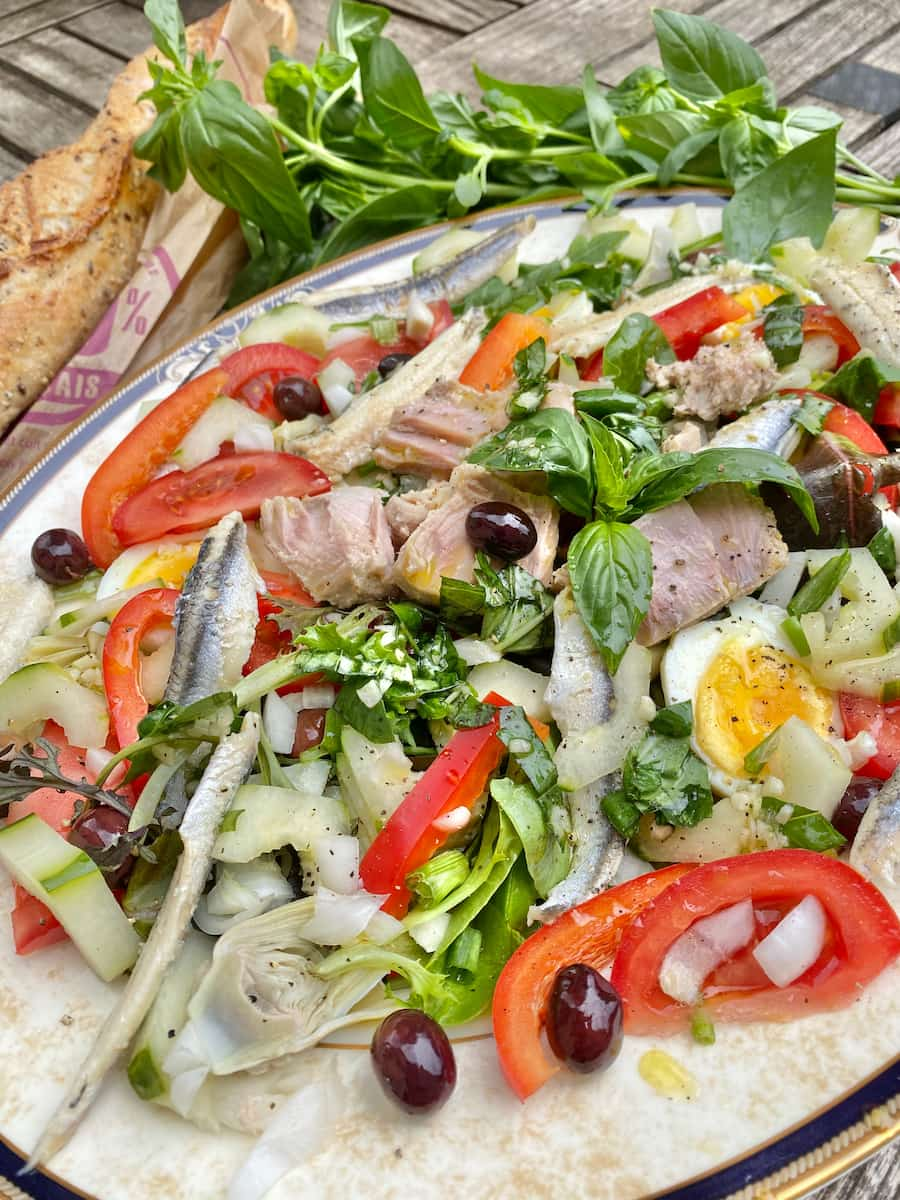
Classic Niçoise Salad - The Ingredient Debate
Unlike other French salads, like the Salade de chèvre chaud or a simple green salad, the Niçoise salad debates around its classic ingredients. Even while I studied in Nice over two summers, I found variations in the salad's ingredients across various restaurants! The same continues today, living in France. It's often different.
Even in the 1960s, the famous French cartoon character, Asterix educated French kids the art of a real Niçoise Salad (5th Album of 'Des Aventures d'Asterix', 1965).
It wasn't until the 1970s that the salad was officially taken in hand by the 2 Jacques: the ex-mayor of Nice, Jacques Médecin, a food enthusiast and ambassador for rekindling the culinary classics of the city.
Together with starred chef and Meilleur Ouvrier de France, Jacques Maximin (10 years chef at the famous Negresco Hotel and restaurant owner in Nice), they collaborated in 1981 to publish the Niçoise salad's genuine local recipe in the book's second edition, 'La Cuisine du Comté de Nice'.
The word was out how to do it properly!
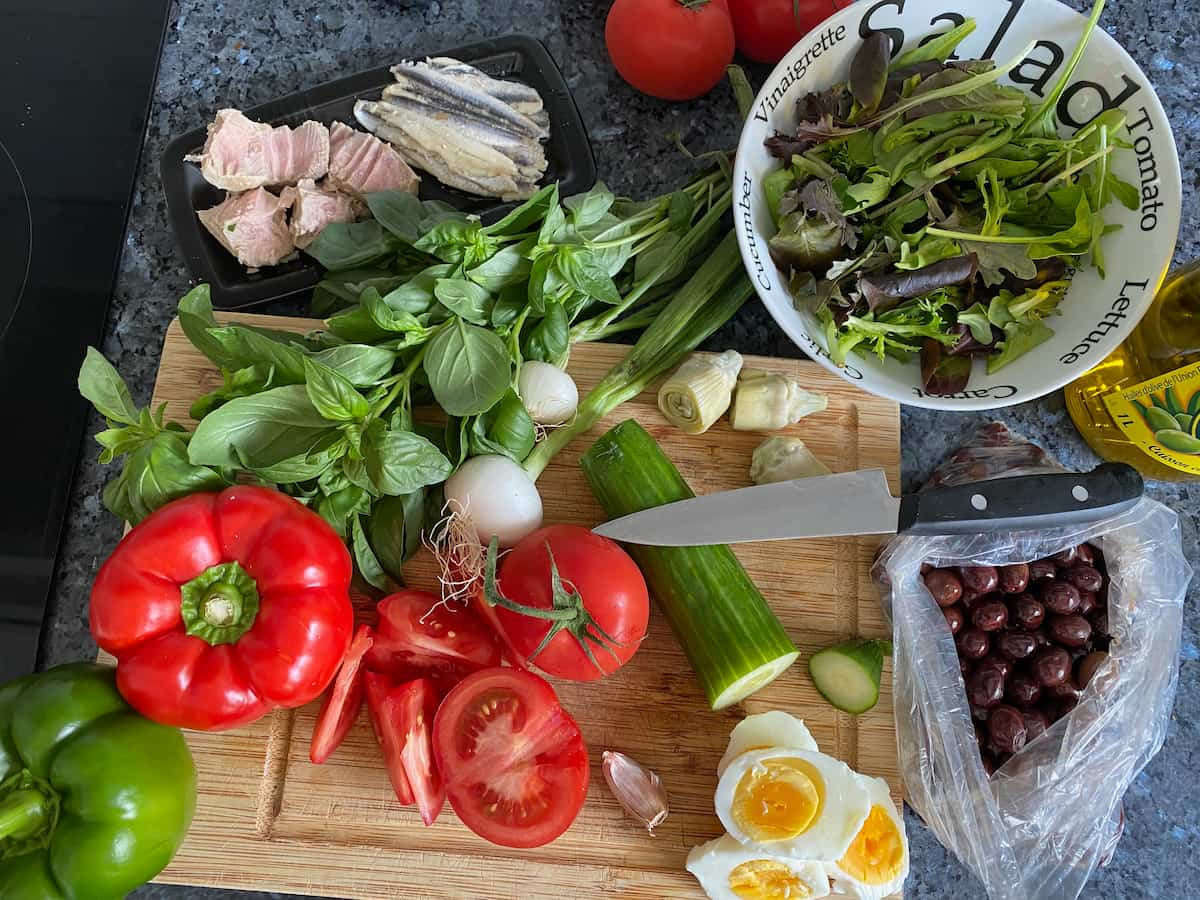
How to Pronounce Niçoise
The correct pronunciation is 'Salade Niçoise' (pronounced 'Nee-swau-ze' or 'Nisuaz'). There's an 'E' at the end, since 'salade' in French is feminine.
I have often heard non-French chefs outside of France pronounce this salad as Niçois ('Nee-swah'). Although it doesn't seem that different, it's a mistake (meaning, a male from Nice). If referring to the salad, it just makes the French shudder if written or spoken incorrectly.
Why is it Called Salade Niçoise or 'à la Niçoise'?
In French cuisine, Niçoise is a culinary term to designate the type of regional speciality around Nice. On menus, if a fish dish is named 'à la Niçoise', grilled fish - such as sole, rouget/red mullet - is usually served with chopped tomatoes, anchovy fillets and olives.
As this salad is originally from the town of Nice in southern France, in French it's called Salade Niçoise, meaning 'Salad from Nice'.
So from southern France, which is right on the Mediterranean coast, it will contain only local, fresh and seasonal ingredients. That's mainly tomatoes, tuna and/or anchovies, garlic, basil, olives and olive oil.
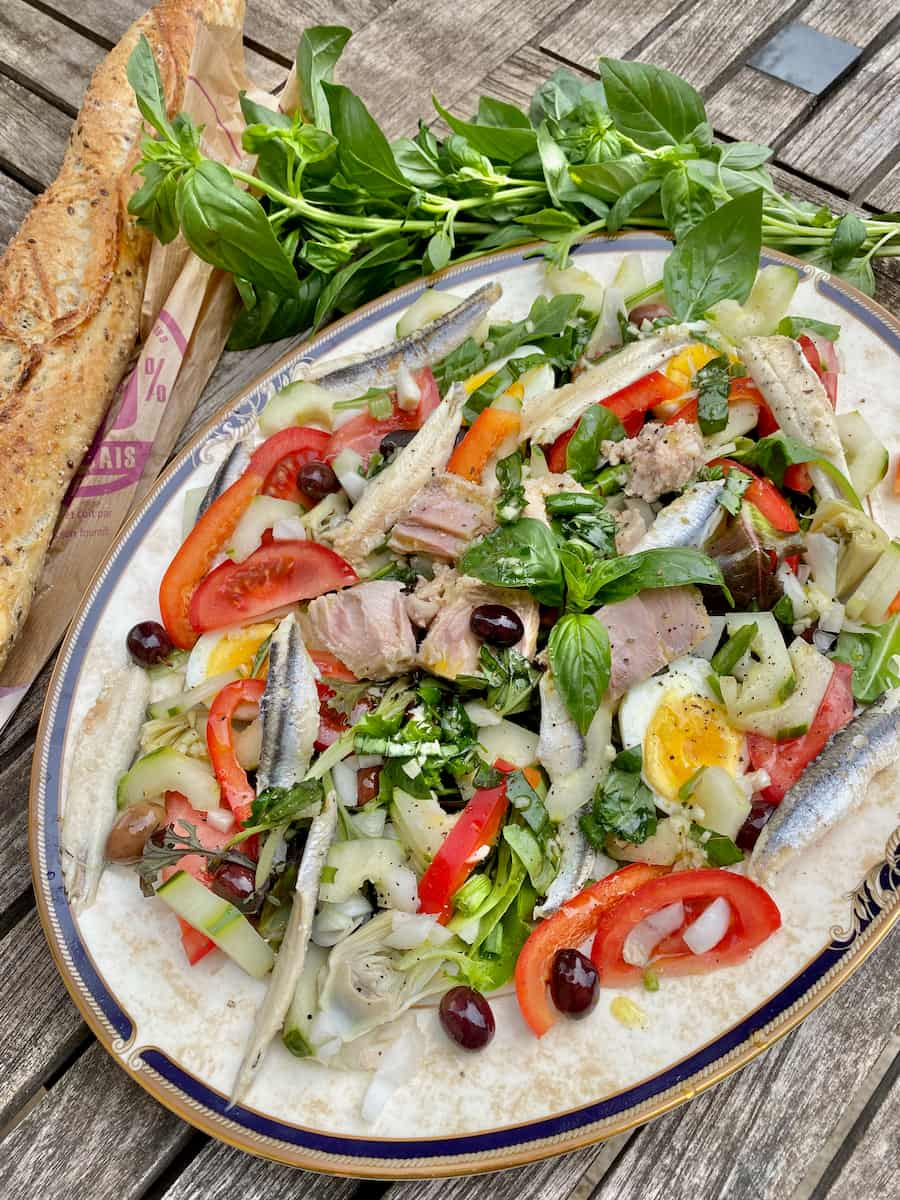
What is in a Classic Niçoise Salad?
As a result, there are authentic, classic ingredients in a Niçoise Salad from Nice. Purists like Gaudry, Jacques Médecin and Jacques Maximin, all precise the following, authentic ingredients with these typical Mediterranean flavours:
- tomatoes
- cucumber
- bell peppers
- spring onions, cebettes or shallot
- olives from Nice - these are the little black olives which are a speciality of Nice
- hard boiled eggs
- tuna (in brine) and/or anchovies
- small artichoke hearts or peeled fève beans ('fevettes'), when in season
- basil - fresh basil leaves, not the dried
- olive oil - with a touch of salt and pepper
- fresh garlic - this is an important ingredient of the Mediterranean and adds that typical touch of spice and flavour. Although served raw, it is finely chopped or crushed to a paste to add to the sauce. Please use a fresh garlic clove and never the dried in powdered form. The taste is not at all the same.
- salad leaves (preferably rocket/arugula, mesclun, pourpier). Even this addition is debatable. It's mixed!
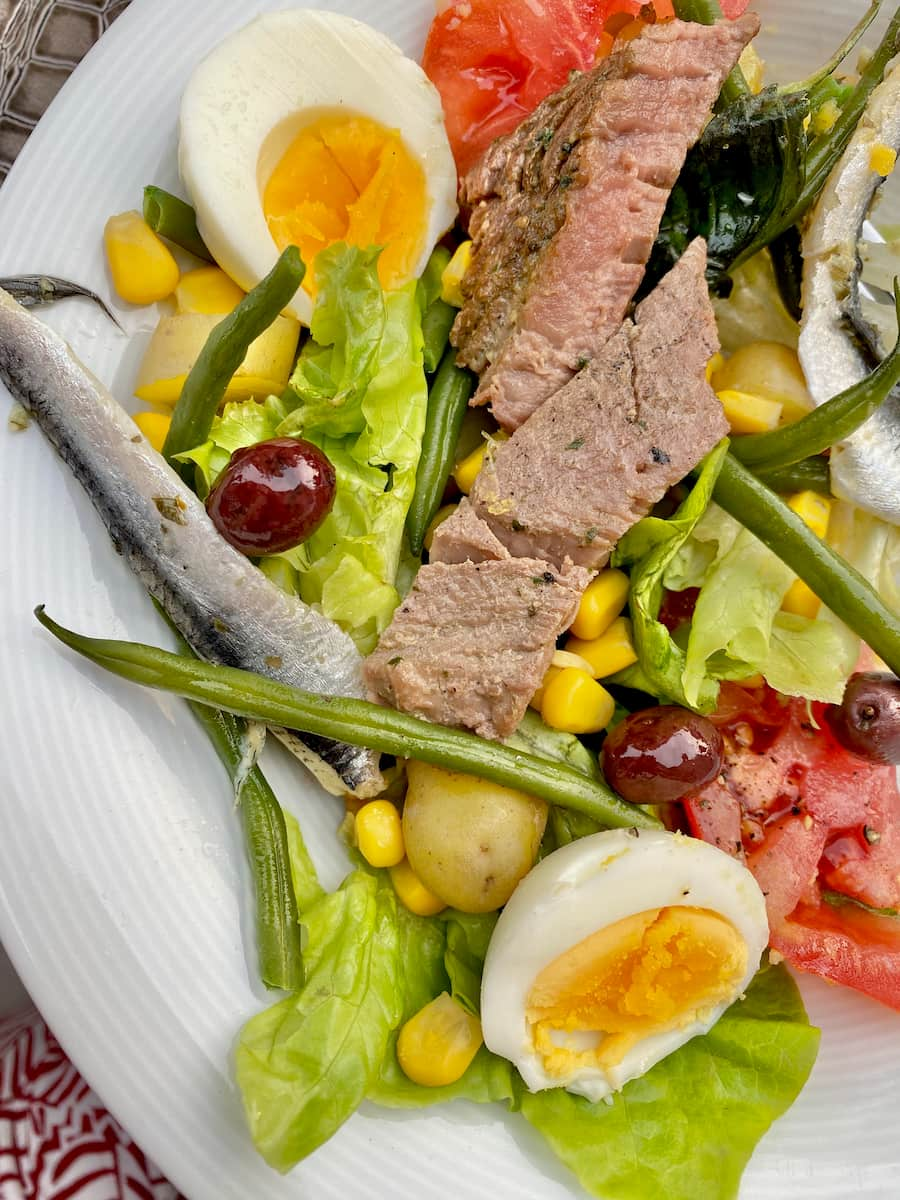
Which of the Following Ingredients are Not Found in a Classic Salad Niçoise?
Even in France, there's confusion about the Niçoise salad. Classic recipes, including those by Auguste Escoffier (in his Guide Culinaire, 1903), often incorporate cooked green beans and potatoes.
This discrepancy might stem from Escoffier's focus on preserving ingredients. He had called for more canning factories to help war efforts - and green beans and potatoes were readily available in cans during his time. Modern French chefs, like Hélène Darroze and Philippe Etchebest, also add their own creative twists, sparking friendly debates among purists.
However, French food journalist François-Regis Gaudry ('On va déguster la France', 2021) argues that these additions are not authentic. Traditionally, the salad features fresh, seasonal ingredients - not cooked vegetables.
Certain ingredients like cooked green beans, potatoes, mustard, vinegar, honey, capers, rice, sweetcorn and any other fish than tuna should NOT be included in an authentic Niçoise salad.
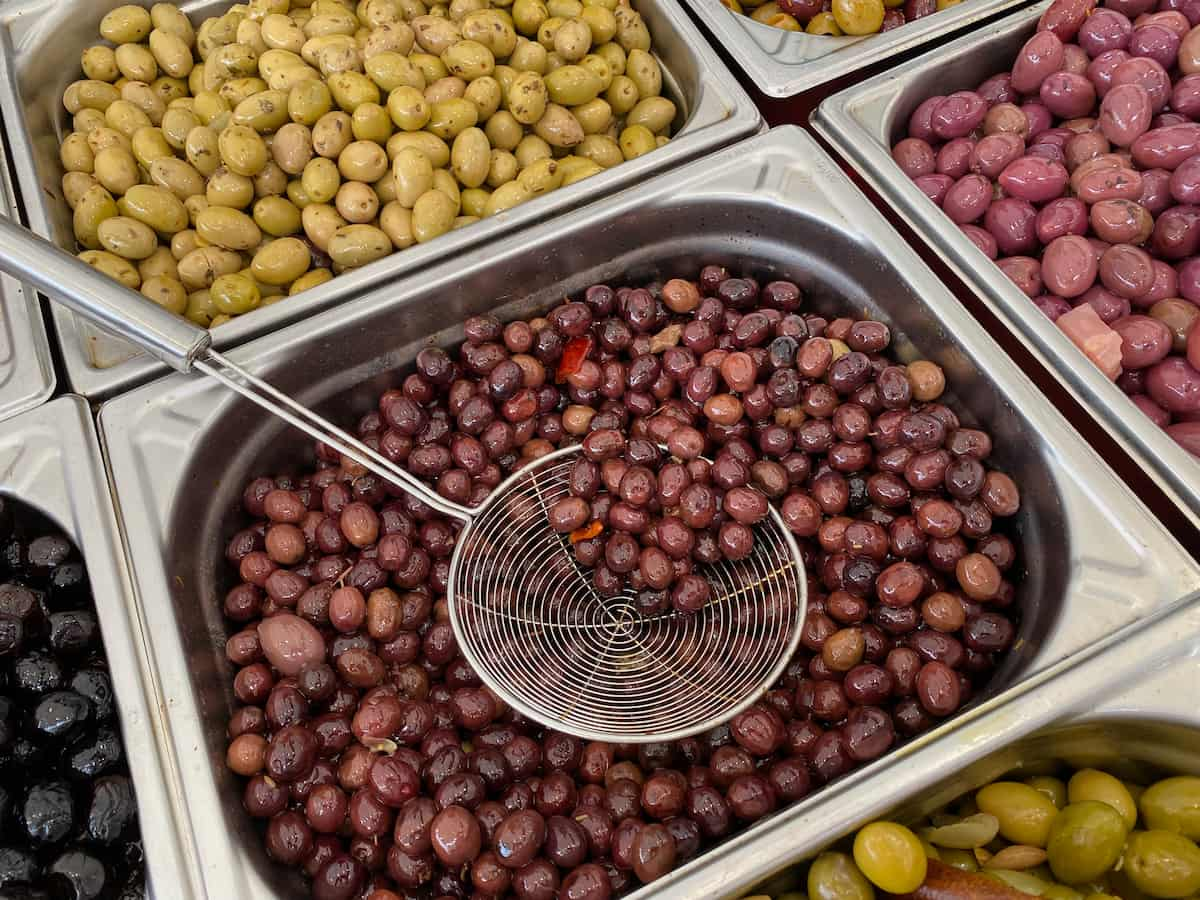
What is a Niçoise Olive?
Niçoise olives are small, deep violet in colour, and have a strong, salty taste with a slight nuttiness. As they're so small, they come with their stones; you will never find them stoned ('dénoyautées' in French).
Conversely, Kalamata olives are much bigger and sweeter. So, if you can't find Nicoise olives, you'll need much less Kalamatas.
Les olives de Nice have their own quality status of AOP (Appellation d'Origines Protégées). So when buying them, ensure they are from a reputable source from the region without a lot of ingredients mentioned on the label.
Traditional Niçoise Salad Recipe
To prepare the best classic Niçoise salad, first hard boil the eggs. In the printable recipe below, I only use 2 for 4 people but if you prefer, aim for an egg per person.
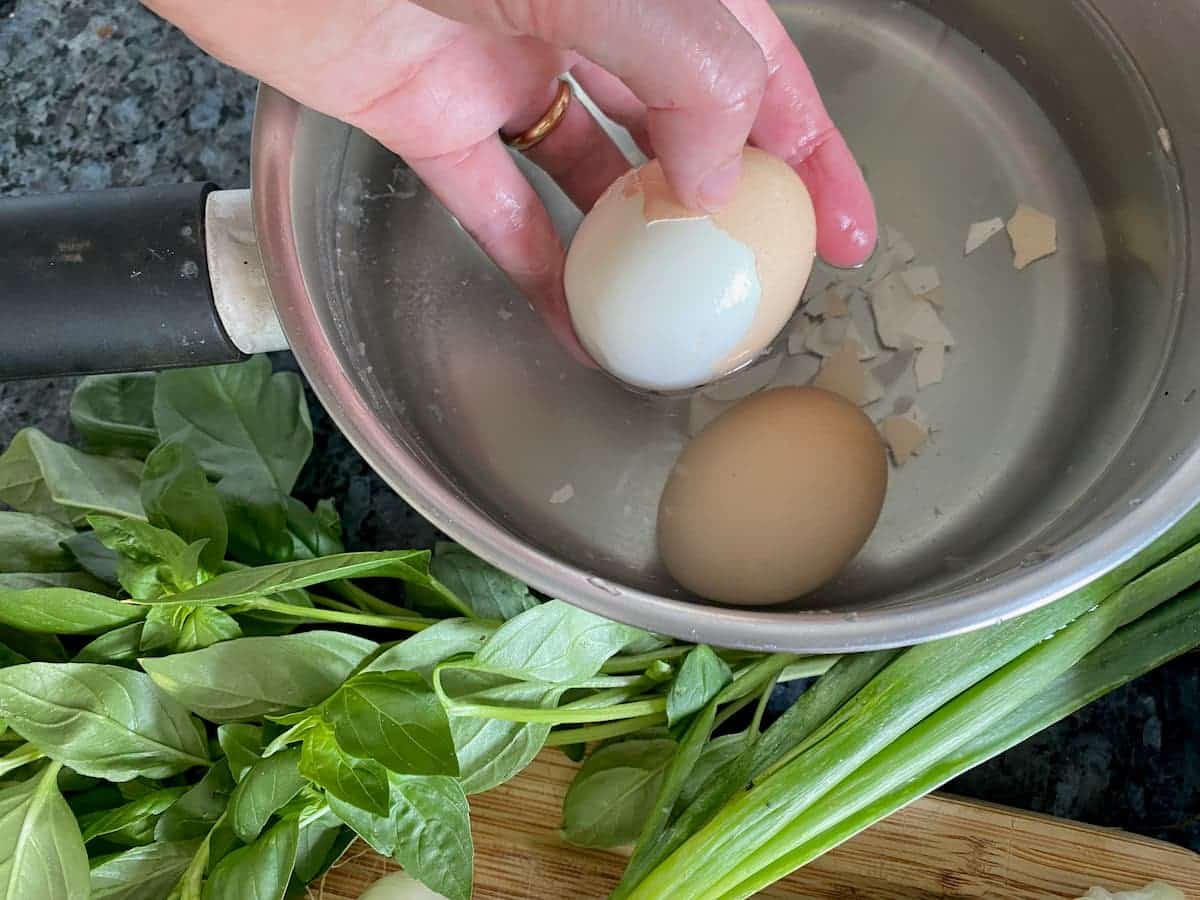
How to Cook Hard Boil Eggs to Perfection
Use the freshest, organic eggs you can find. Boil the eggs for 10-15 minutes, depending on their temperature.
If eggs are at room temperature, cook for 10 minutes in simmering water to get the best hard boiled egg. For chilled eggs out of the fridge, cook for no longer than 15 minutes. The cooked egg yolks should remain fluffy and maintain their lovely yellow colour.
Cooking any longer will result in rubbery eggs and their yellow colour will fade. The worst is when they turn a little grey and start to smell of sulphur - a sure sign they're well overcooked.
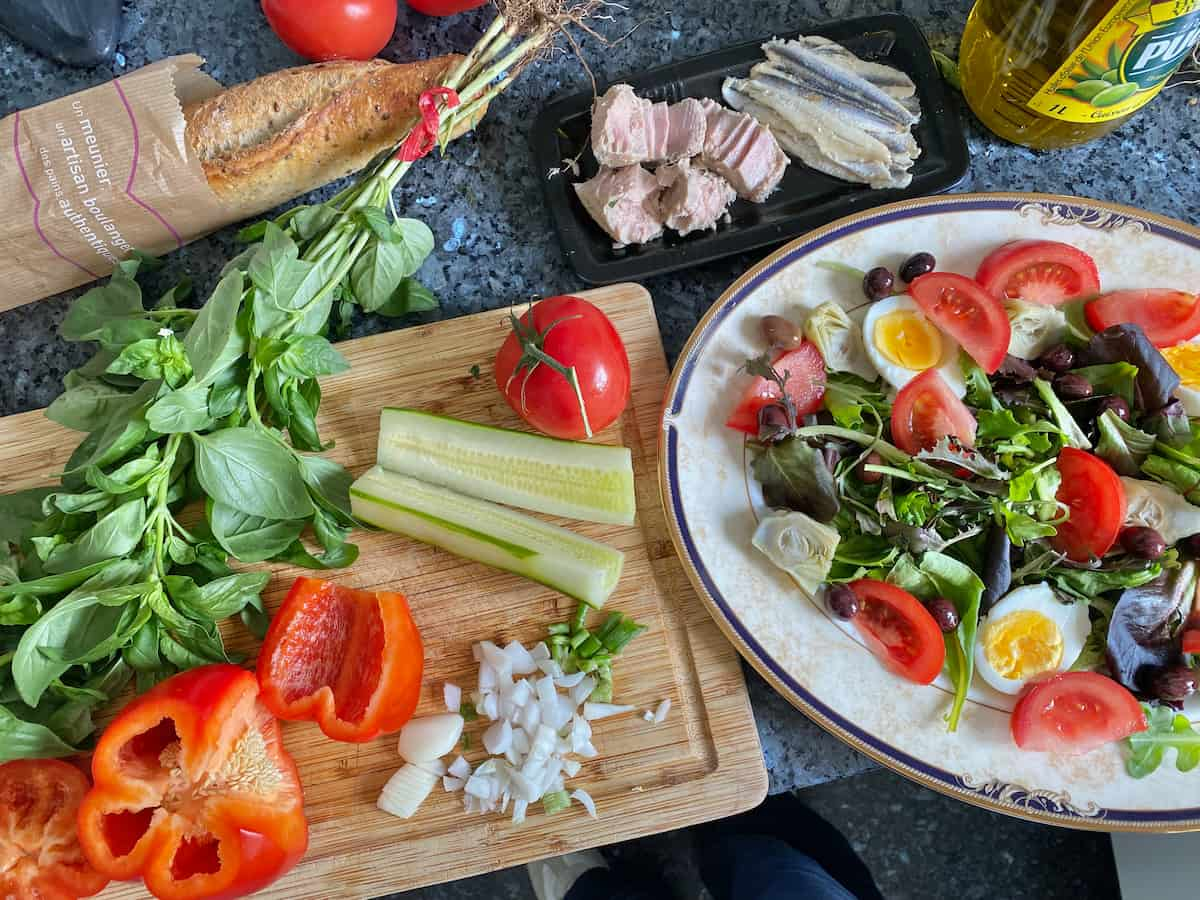
Assemble all ingredients. As we want to taste the typical flavours of the Mediterranean, use the freshest produce you can find in season. This includes vine tomatoes, fresh basil and garlic.
Salad Tuna and Anchovies
Use tinned tuna and/or anchovies. Fresh anchovies in oil are not as strong as regular tinned or bottled anchovies conserved in salt (that's why I use more here).
Use a good quality brand of anchovies and, if stored in the fridge, remove them 20 minutes before to enjoy them at their best.
For more, see aromatic fresh herbs and tomatoes
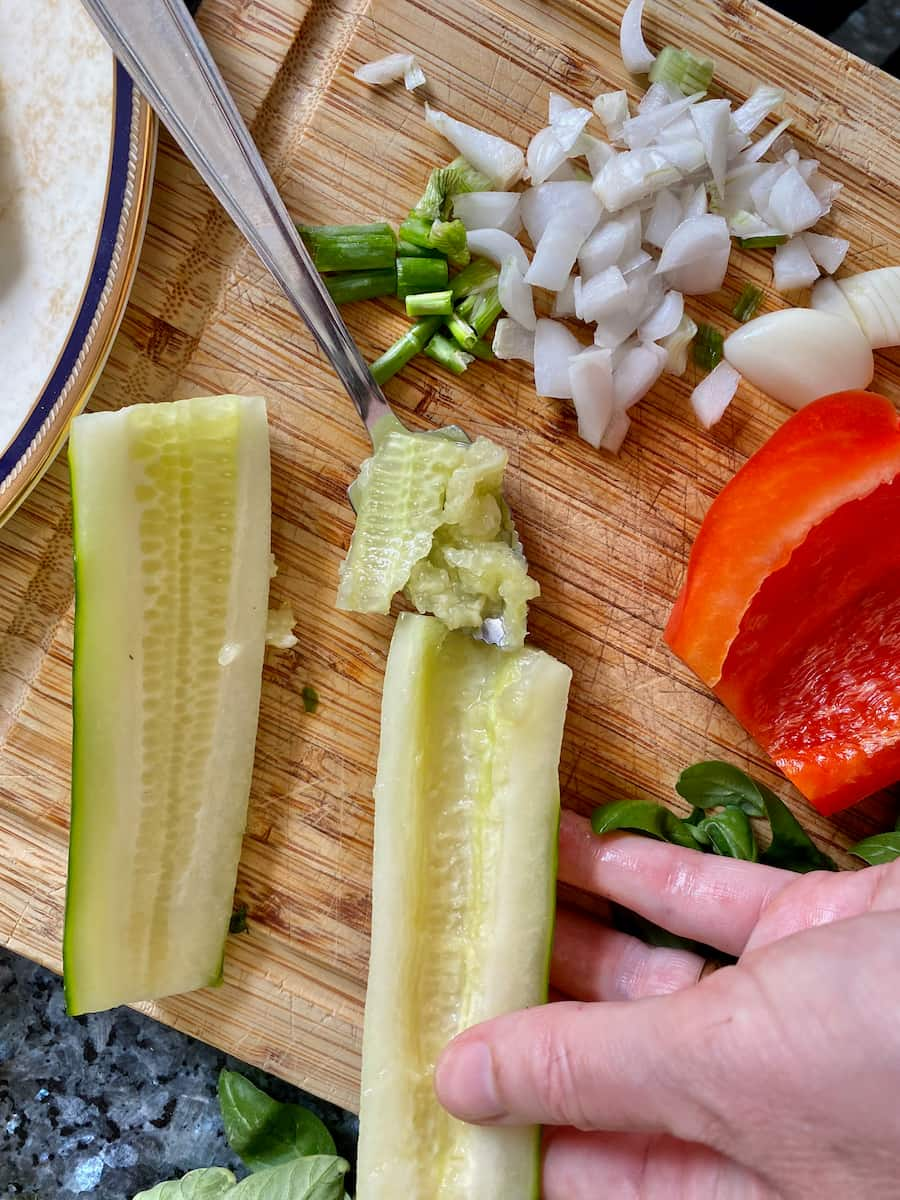
Prepare the cucumber: cut it vertically in half and scoop out the seeds with a spoon. Even better, use a serrated grapefruit knife. Then chop into thin slices.
Chop all the remaining ingredients and assemble on a large serving plate.
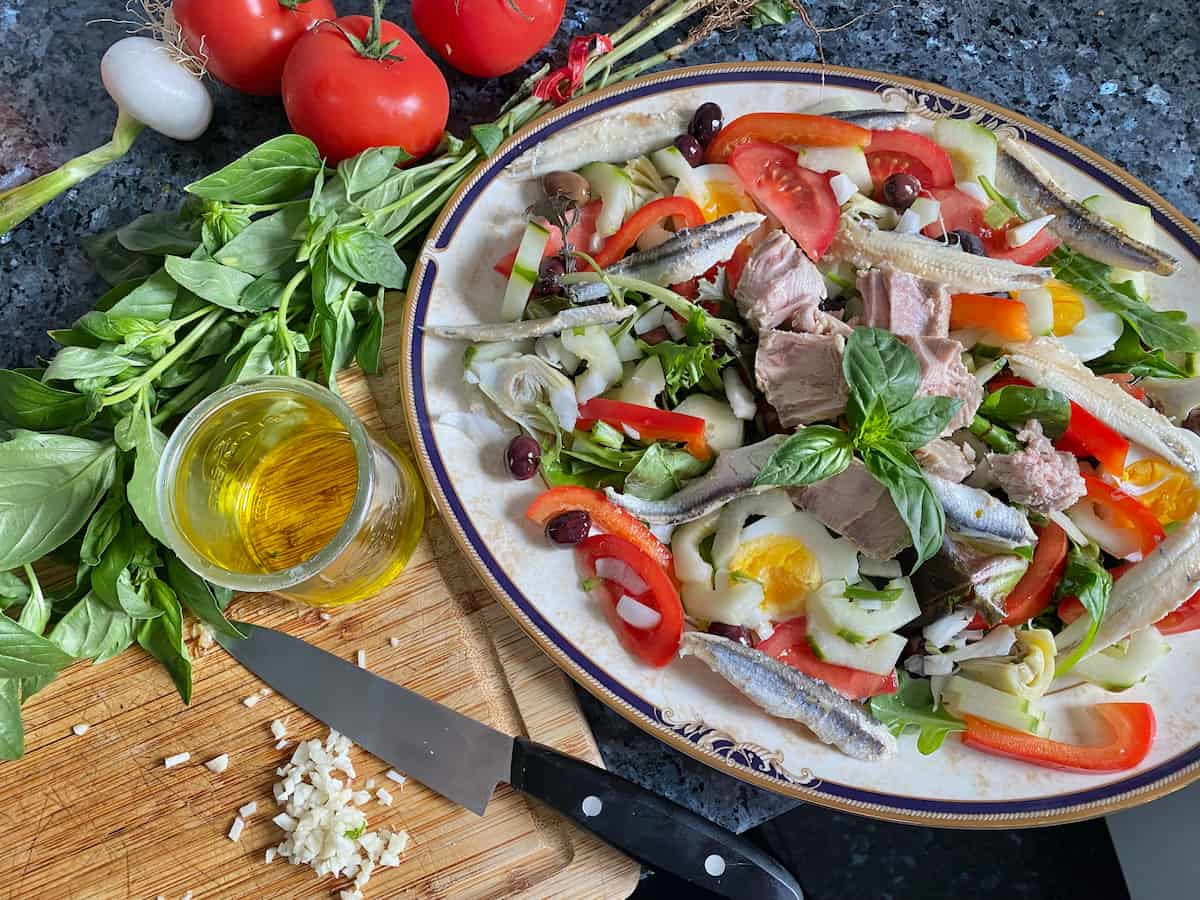
What is Niçoise Salad Dressing Made Of?
The classic salad dressing is made with good quality, extra virgin olive oil, garlic, fresh basil, lemon juice (optional) and fleur de sel or sea salt.
The dressing is poured over the salad, rather than tossed in it.
Garlic in Salad Dressing?
Worried about adding raw garlic to the dressing? Not everyone loves the powerful taste of fresh raw garlic in a salad. So, to make a lighter version, first rub the garlic clove liberally around the serving dish (says chef Jacques Maximin and Médecin).
Otherwise, finely chop the garlic and crush it further with the blade of the knife. I personally love garlic so much, I just chop it finely and serve. Please don't use powdered garlic; the taste is nasty and nothing like the real flavours of the Mediterranean.
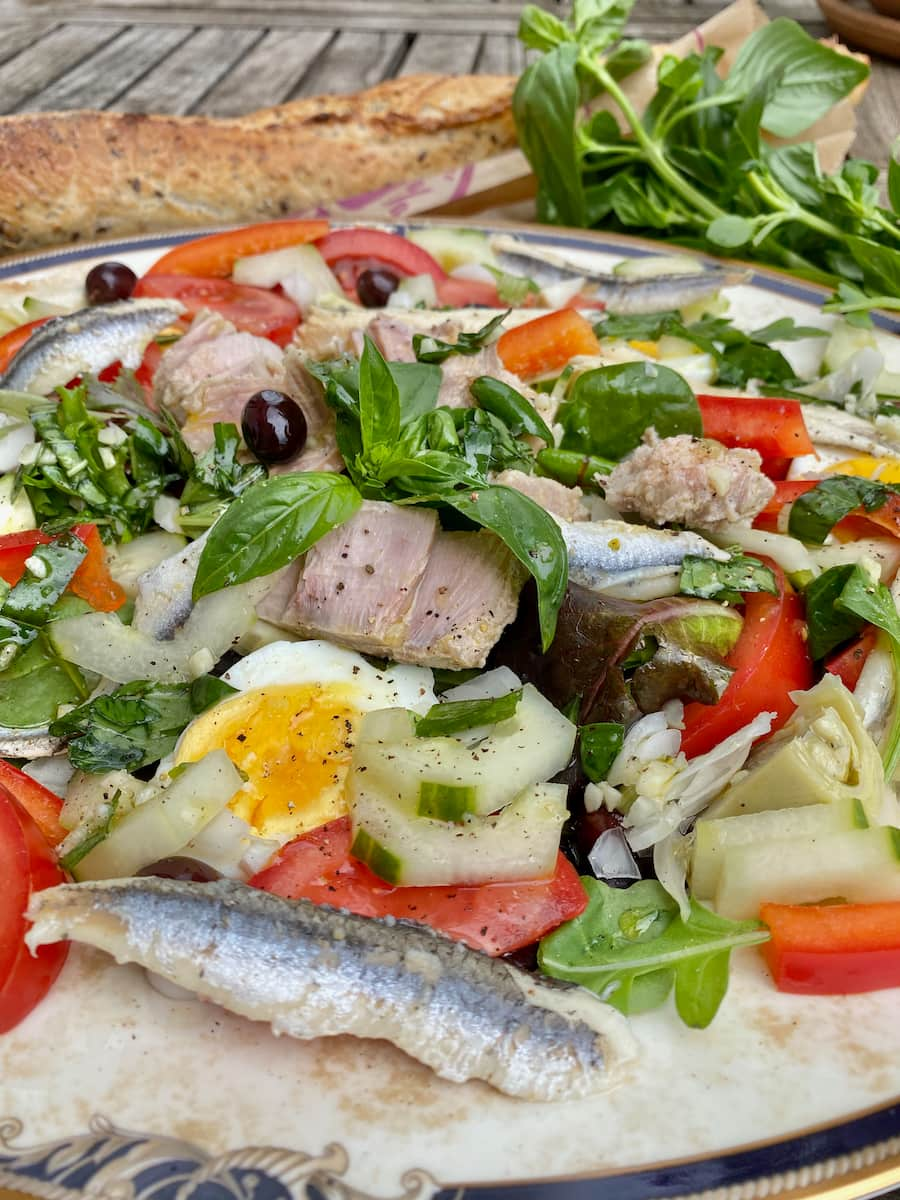
How to Serve
The salad (salade composée) should normally be composed on the plate, with each ingredient arranged separately. Above, you'll see I mixed them; the jumbled approach resembles my way of thinking!
So, without any cooked vegetables, this classic Niçoise salad is much quicker to prepare, ready in just 30 minutes. Perfect for easy summer meals in hot weather.
So use the extra time, 'wine down'; serve with a good crusty baguette, a chilled glass of Rosé de Provence and bring on the sunshine.
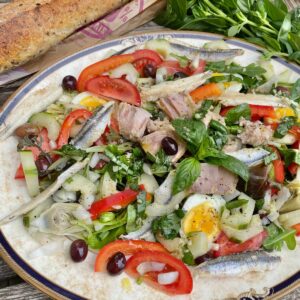
Niçoise Salad
Ingredients
- 2 eggs organic (to be hard boiled)
- 6 vine tomatoes quartered
- 150 g (regular tin) tinned tuna in brine or oil
- 8 anchovy fillets (see notes)
- ½ cucumber peeled, seeds removed and chopped
- salad leaves Mesclun or rocket (arugula)
- 1 green or red pepper deseeded and chopped
- 100 g black Niçoise olives (includes stone)
- 1 spring onion or shallot finely chopped
- 6 small violet artichokes (if in season) raw and sliced (or small raw fève beans)
Dressing
- 4 tablespoon olive oil extra virgin
- 1 clove garlic chopped then crushed to a pulp
- 12 fresh basil leaves finely chopped
- fleur de sel sea salt Maldon salt flakes or Celtic salt
- pepper freshly milled
Instructions
- First prepare the hard boiled eggs. Cook room temperature eggs for 10 minutes in simmering water. (If chilled eggs out of the fridge, cook for no longer than 15 minutes.) Leave to cool by plunging in cold water then peel shells while water still warm. Cut each in half.
- Cut the tomatoes into quarters and salt slightly. Peel and halve the cucumber vertically, scoop out the seeds and slice finely. Chop the other fresh vegetables. Either assemble all ingredients mixed or compose an arrangement by each ingredient on the plate.
Dressing
- Chop the garlic finely then, using a sharp knife, crush or press to a pulp. Add to a bowl of olive oil, stir in the chopped basil and season with salt and pepper. Pour over the salad.
Notes
A Note on Ingredients
Use the best quality of fresh ingredients you can and find. Only the eggs are cooked in this salad (hard boiled). Tuna fish is often replaced by anchovies and vice versa. Small artichokes are often replaced by fresh fevettes (little beans) but both ingredients are only used when in season.Worried about the raw garlic? Instead rub the garlic clove on the presentation plate before dressing. Depending on the quality of tomatoes, these are often peeled (drop in boiling water for a minute first to peel) or replaced by cherry tomatoes. Each portion provides 14g of protein.



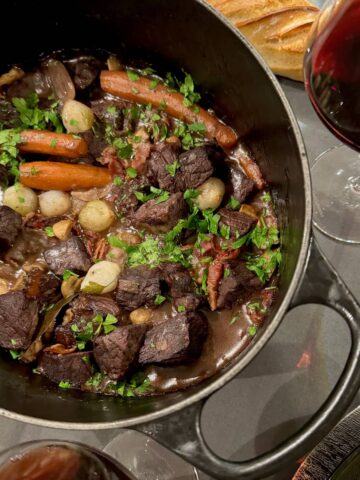
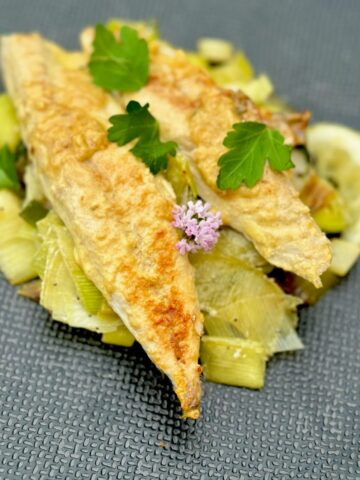

Antoine
I’ve always wondered if green beans and potatoes are supposed to be in a classic Niçoise salad. Even if I’m French, it’s not always evident what’s not in the classic! Thanks for the info and authentic recipe - it’s great. LOVE these little olives - think we need to stock up from the South.
Jill Colonna
Aha - it's not obvious in France, is it? Anyway, let's try and spread the word - no more green beans or potatoes if we keep it an authentic Nice recipe.
Keith
Forget all the recipes with weird ingredients that the French would never put in a salade niçoise : this is THE genuine recipe of someone who lives in France for >30 years 🙂 Thank you Jill Colonna for this
Jill Colonna
Gosh, thanks Keith. However, even the French do get confused on this too, at times!
June
I’ve enjoyed this so much in Nice years ago and so happy to find the real classic here! Wonderful
Jill Colonna
It's a real pleasure to share.Thanks!
Devra Long
This is a classic and perfect for a hot summer night!! The flavors all blend together! These are ingredients that we usually have on hand and simple to compose! Mouthwatering delicious !
Jill Colonna
So glad you had all the ingredients to hand and this recipe came out just in time for you, Devra. Thanks x